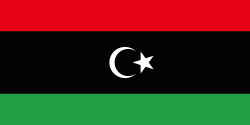Tarhuna
Tarhuna (ترهونة), also Tarhoona or Tarhunah, is a Libyan town 65 km to the southeast of Tripoli, in the Murqub District. The city derives its name from that of its pre-Roman-era inhabitants, a Berber tribe. The city was known as al-Boirat during the 19th through mid 20th century but assumed its current name after Libyan independence. The Tarhuna District, including the city of Msallata, had an urban population of about 296,000 (est. 2003). The population in Tarhuna proper was calculated to be 13,264 in 2011.
Geographical boundaries: from the "Valley of the famm Molgha" west to "Burkaat Oueny" eastward. Then from the "Suq al Juma (Al-msab`ha)" north, " Al-mzawgha and Marghna" south.
In the city centre of Tarhuna, just opposite the Tarhuna mosque, there is a memorial to Ali Swidan Alhatmy, who was a hero in the 18 June 1915 Battle of El-Shqiga against the Italians. He was captured in 1922 and hanged by the Italians in the town square.
The population generally belongs to the Tarhuna tribe, which was favoured during the regime of Muammar Gaddafi. In late August 2011 (as part of the Libyan Civil War), opposition forces from the National Liberation Amy entered Tarhuna, amidst mixed feelings from the citizens.
On 23 August 2012, Interior ministry spokesman Abdelmonem al-Hur stated that more than a hundred tanks and twenty-six rocket launchers were seized from an alleged pro-Gaddafi militia (named Katibat Al-Awfiyah, or Brigade of the Faithful), during a raid on their campsite in Tarhuna. The operation ended with one of the suspects killed, eight wounded and thirteen detainees, accused of being linked with the 19 August Tripoli bombings.
According to reports in The Washington Post, Tarhuna was dominated between 2011 and 2020 by the Kani brothers and their militia, the Kaniyat. Imposing a reign of terror, the Kaniyat were allegedly responsible for hundreds of killings in the town, with the collusion of the Government of National Accord. In 2019, the Kaniyat switched allegiance to the warlord Khalifa Haftar-led LNA forces during the Second Libyan Civil War, and became the LNA's stronghold in western Libya. On 18 April 2020, the forces of the UN-recognized GNA government, with the backing of Turkish drones, launched a major offensive with the aim to reclaim Tarhuna from Haftar. On 5 June, it was captured by the GNA. Explosive devices, landmines, and mass graves of civilians, many buried alive, were discovered in the city.
Geographical boundaries: from the "Valley of the famm Molgha" west to "Burkaat Oueny" eastward. Then from the "Suq al Juma (Al-msab`ha)" north, " Al-mzawgha and Marghna" south.
In the city centre of Tarhuna, just opposite the Tarhuna mosque, there is a memorial to Ali Swidan Alhatmy, who was a hero in the 18 June 1915 Battle of El-Shqiga against the Italians. He was captured in 1922 and hanged by the Italians in the town square.
The population generally belongs to the Tarhuna tribe, which was favoured during the regime of Muammar Gaddafi. In late August 2011 (as part of the Libyan Civil War), opposition forces from the National Liberation Amy entered Tarhuna, amidst mixed feelings from the citizens.
On 23 August 2012, Interior ministry spokesman Abdelmonem al-Hur stated that more than a hundred tanks and twenty-six rocket launchers were seized from an alleged pro-Gaddafi militia (named Katibat Al-Awfiyah, or Brigade of the Faithful), during a raid on their campsite in Tarhuna. The operation ended with one of the suspects killed, eight wounded and thirteen detainees, accused of being linked with the 19 August Tripoli bombings.
According to reports in The Washington Post, Tarhuna was dominated between 2011 and 2020 by the Kani brothers and their militia, the Kaniyat. Imposing a reign of terror, the Kaniyat were allegedly responsible for hundreds of killings in the town, with the collusion of the Government of National Accord. In 2019, the Kaniyat switched allegiance to the warlord Khalifa Haftar-led LNA forces during the Second Libyan Civil War, and became the LNA's stronghold in western Libya. On 18 April 2020, the forces of the UN-recognized GNA government, with the backing of Turkish drones, launched a major offensive with the aim to reclaim Tarhuna from Haftar. On 5 June, it was captured by the GNA. Explosive devices, landmines, and mass graves of civilians, many buried alive, were discovered in the city.
Map - Tarhuna
Map
Country - Libya
 |
 |
| Flag of Libya | |
Libya has been inhabited by Berbers since the late Bronze Age as descendants from Iberomaurusian and Capsian cultures. In classical antiquity, the Phoenicians established city-states and trading posts in western Libya, while several Greek cities were established in the East. Parts of Libya were variously ruled by Carthaginians, Persians, and Greeks before the entire region becoming a part of the Roman Empire. Libya was an early center of Christianity. After the fall of the Western Roman Empire, the area of Libya was mostly occupied by the Vandals until the 7th century when invasions brought Islam to the region. In the 16th century, the Spanish Empire and the Knights of St John occupied Tripoli until Ottoman rule began in 1551. Libya was involved in the Barbary Wars of the 18th and 19th centuries. Ottoman rule continued until the Italo-Turkish War, which resulted in the Italian occupation of Libya and the establishment of two colonies, Italian Tripolitania and Italian Cyrenaica (1911–1934), later unified in the Italian Libya colony from 1934 to 1943.
Currency / Language
| ISO | Currency | Symbol | Significant figures |
|---|---|---|---|
| LYD | Libyan dinar | لد | 3 |
| ISO | Language |
|---|---|
| AR | Arabic language |
| EN | English language |
| IT | Italian language |















